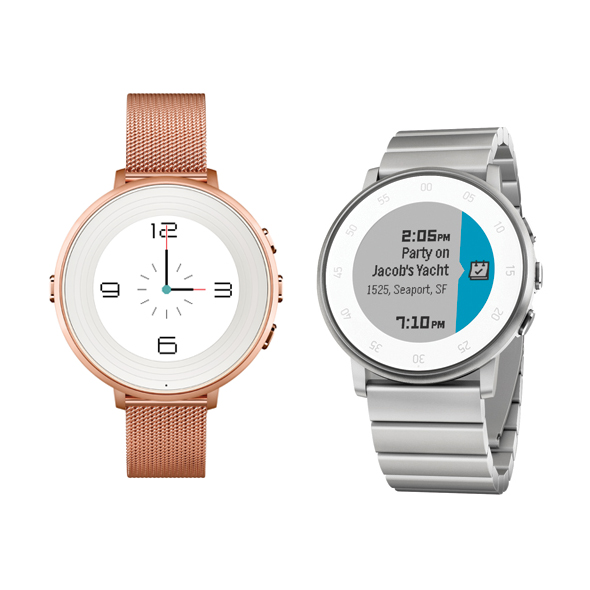
“Winning a place on someone’s body is much harder than winning a place in someone’s purse,” says Pebble Head of Industrial Design, Mark Solomon, describing the features that make Pebble smart watches so deserving of a spot on that prime real estate otherwise known as the wrist. Interestingly, the Founder and CEO of Pebble, Eric Migicovsky, who came up with the concept while studying abroad in the Netherlands in 2009, initially thought about creating a bike computer, not a watch. In his then current location, he was experiencing a vexing issue: he was spending a lot of time riding his bike, and could feel his phone vibrating, but couldn’t safely reach it. The idea of a watch eventually gained traction in his mind, because most people are very familiar with wearing something on their wrist.
Back in the dark ages of 2009, however, wearable technology was in its infancy, and even today, most of the wearable technology out there doesn’t look like something one would wear outside of the gym, bike, or running trail, at least outside of the microcosm known as Silicon Valley. Enter the first smart watch that actually looks like, well, a watch. Sometimes it’s not necessary to reinvent the wheel. “Watches have been around for hundreds of years, if not more,” says Solomon, “so many things have already been learned.” With Pebble, wearers can collect a variety of faces and straps, and swap them out. This feature makes Pebble watches, and in particular the Pebble Round watch, attractive to a more trend-driven demographic. The Pebble Round was born when the Pebble team chatted with women both within and out of the company about their needs. A female designer was brought in to weigh in on colors, materials, and finishes, and hundreds of prototypes were created before settling on the slim-line current model, which could pass for a fashion watch, but which is compatible with iPhone or Android, and pairs with Misfit and Jawbone, to do most of the things our phones can do, without actually having to fumble for the phone.

“With the Pebble,” says Solomon, we found that once users put it on their wrist, they never want to take it off, because of the experience and the usability.” These are the very features that made Pebble’s Kickstarter campaign in 2012 the most successful one of all time, raising 10 million dollars in under 30 days. Pebble Time is not only the most funded campaign in Kickstarter’s history, eventually raising a total of over 20 million dollars, but it’s also the fastest funded, raising $1 million in less than an hour. Still, Pebble is a comparatively small company. Its team members refer to the story of David and Goliath, and point out how they must prioritize when it comes to the features that will be available on the Pebble. “We don’t necessarily try to redesign the watch, but rather the experience,” says Solomon. “Then again, I speak from a nerd zone.” He means that, in Pebble models other than the petite and pretty Pebble Round, the priority is on performance rather than looks. Which is not to say that the Pebble Time watches are ugly. They’re not. They’re perhaps a bit less slick looking than some, but that comes down to carefully weighed decisions.
One interesting detail that differentiates the Pebble Time from competitors, for example, is the use of external buttons rather than a touch screen. “If we have a touch screen, what does that bring to the table?” asks Solomon, referencing the physically active community that makes up the majority of Pebble adopters. The Pebble watches are very water resistant, but a touch screen does not work underwater, or when wet. Looking at a screen and having to touch multiple spots on it to perform simple tasks takes too much time and attention. It’s an unneeded interruption. Not to mention, the buttons deliver a more typically watch-like experience. Another interesting tech detail is the always on, color e-paper display with LED backlight. It may look less sharp than some, but it does the job, remains visible even in strong sunlight, and takes up much less battery life. In fact, the Pebble Time Steel watch can stay charged for up to ten days, and the Pebble Time Round takes a mere 15 minutes to recharge a full day’s worth of power. With Pebble, simplicity and ease of use are key. According to its creators, such an item should be easy, quick, and painless to use. Apps are automatically available on the Pebble, and are all constantly updated in a seamless manner. Chris Matthews, Pebble’s Brand Director, explains, “We take care of our community in ways that other large companies don’t.” He references regular software updates, and the launch of a new iPhone App containing new layouts and features, with ways to select which notifications go to the watch. “Everybody gets updates, and they’re always free. When Pebble Health was launched in December, the free health tracker became available to everyone who had a Time-series watch. It’s Pebble’s way of taking care of people.” This strategy works, as reflected by the overwhelming positive comments on Pebble’s Facebook page. Matthews often references this community of people who connect through Pebble. “They’re the tech community and the hackers, not the criminal ones, but the DIY folks, who naturally gravitate towards Pebble because it’s very open to letting people build on the platform- anyone can develop a watch face or app.”
Text by Karena Gupton Akhavein

